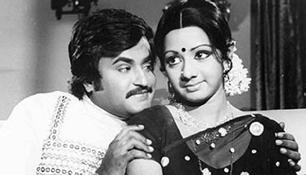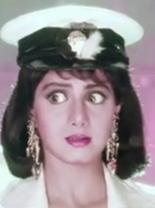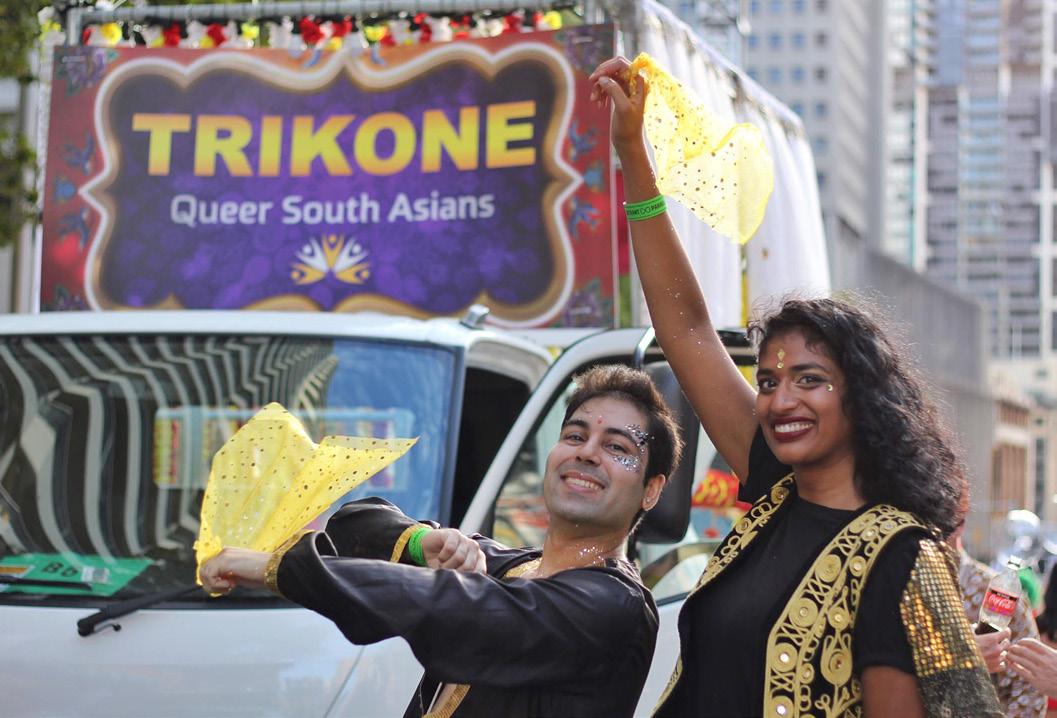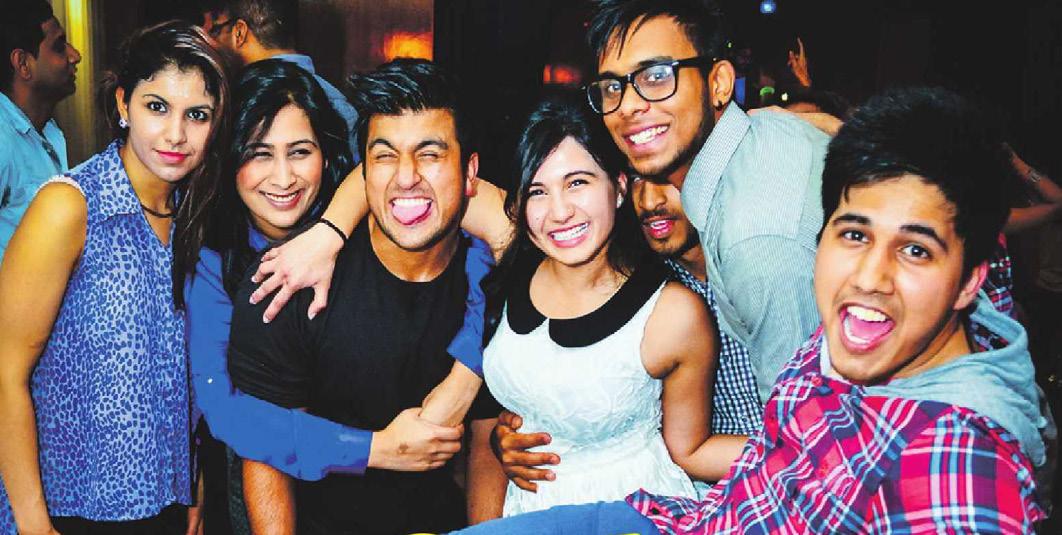












































As Australia’s energy system transitions, the Australian Government is making energy more affordable. We have a plan for a National Energy Guarantee to build a better energy system for the future, and have secured agreements from retailers to offer consumers a better deal. Switching providers can save some households up to $1,500 per year. We’re also ensuring there is enough gas for Australians before it’s shipped off shore.
It’s actions like this today that are powering a more affordable energy future.


Pawan Luthra
EDITORRajni Anand Luthra
ASSISTANT EDITOR
Harshad Pandharipande
MELBOURNE COORDINATOR

Preeti Jabbal
CONTRIBUTORS
Aneeta Menon, Dipanjali Rao, Aparna Ananthuni, Kashif Harrison, Shampa Bhattacharya Bruweleit, Radhika Bhirani, Radhika Bhatia, Rachel V Thomas, Chitra Sudarshan, Priyanka Tater, Nury Vittachi
ADVERTISING MANAGER
Vivek Trivedi 0410 578 146
ADVERTISING ASSISTANT
Charuta Joshi 02 9279 2004
Indian Link is a fortnightly newspaper published in English. No material, including advertisements designed by Indian Link, may be reproduced in part or in whole without the written consent of the editor. Opinions carried in Indian Link are those of the writers and not necessarily endorsed by Indian Link. All correspondence should be addressed to:
INDIAN LINK MEDIA GROUP
Level 24/44 Market St, Sydney 2000
GPO Box 108, Sydney 2001
Ph: 02 9279-2004
Fax: 02 9279-2005
Email: info@indianlink.com.au
 BY PAWAN LUTHRA
BY PAWAN LUTHRA
For most migrants, the early years of settling into a new home are a time of careful money management, if not financial crunch.
From the smallest purchase of kitchen basics, to the major acquisition of their first property, their financial journey is fraught with cautious organisation, and navigated through balancing work and family life, kids’ schooling, and oftentimes, responsibilities of family back home.
Gone are the days when men traditionally took control of the family finances, especially as Indian migrants to Australia are increasingly falling in the educated middle-class category. Yet, the need is stronger now for more women to gain more knowledge and understanding about money and its management.
Today, when women have more choice than ever before, a higher level of education and qualifications than ever before, higher paid jobs than ever before (that significant pay gap notwithstanding), there is no excuse for them to lag behind in their financial management skills.
It is important that they do take time out and start understanding the bigger picture of wealth creation, so that they are
financially empowered and take those dayto-day decisions with proficiency.
Upon migration, men may find work quicker and start on their employer-funded mandatory superannuation savings sooner, while their partners may take longer to get into the work force or work less hours as they juggle with their maternal and family responsibilities and work.
With these constraints and a pay gap with their male colleagues, according to the Association of Superannuation Funds of Australia, a woman’s superannuation balance is on average 43% less than that of a man. Their research shows that average super balances at retirement currently are $292,500 for men and $138,150 for women. Estimating that a single person needs about $800 per week in retirement, they need to have over $500,000 in superannuation for a comfortable old age.
Another issue to note is that the average life expectancy of women in Australia is 87 years, higher than that of men at 83 years. This means that women will need more funds, and be able to manage their own savings at some point in their life.
So there’s a high likelihood that due to death or even divorce, women may have not only less savings, but will also be responsible for their household’s finances.
Women simply have to get serious about their own financial planning. They need to understand cash flow management, budgeting and planning their monies.
They also need to understand about the
various types of insurances available in Australia. In the past few years, there have been unfortunate incidents where a partner has passed away unexpectedly and appeals to the community have gone out to help with short-term expenses for the family.
The community has rallied behind the families at these times. However, to ensure there is long-term security for the family, it is important that the appropriate type of insurances are in place. Women must take greater initiative in understanding and implementing this for their families.
But where to start?
First up, ask questions. Ask friends and family about what they do, and how. Do not be afraid to ask questions on money matters, even if they appear trivial to you.
Get involved in the day-to-day management of your family’s finances if you are not already doing so.
Read about money matters in major newspapers, and listen to related discussions on TV and radio. Use social media to understand more details.
Take time out to attend financial management programs for women. A number of work places and superannuation funds run women-only seminars. Seek these out and let your partner mind the little ones for the evening, while you go out to learn more at these forums. Get empowered in any way you can.
Alongside your professional, physical and emotional well-being, set some time aside to plan for your financial well-being.
Ahead of his film’s premiere at Mardi Gras, gay activist and film director Sridhar Rangayan spoke to HARSHAD PANDHARIPANDE
Rhythms-ofPeace Seva wrote: Congratulations to Indian Link and Harshad on the article Coming out of the shadows! This is an issue that needs to be aired and heard widely. Well done Sridhar on your initiative and good luck to you - you deserve it!

A book written by WA resident Laxmi Tiwari was unveiled recently. PUNEET ANAND reported

Varun wrote: She is my aunt and she is an amazing, lovely human being. The novel is truly top notch and I would recommend it to anyone who wants to read Hindi literature.
AMIT DASGUPTA wrote about China’s growing influence in Sri Lanka’s major infrastructure projects
Jagannath Mazumdar wrote: I read with interest the thought-provoking article, India’s Sri Lanka challenge, by Amit Dasgupta. I think Mr Dasgupta should have written this article long ago, when he was occupying a powerful position in the Indian Foreign Service. Things are getting a bit late for India. However, better late than never! The people and Government of India should realise the consequences of this development.

Indian Link Radio anchor Pavitra Shankar asked her Facebook followers which Sridevi movie was their favourite
Manisha Vakiti wrote: Chaalbaaz and Mr India
Haytinder Kaur wrote: Lamhe
Jayanthi Vellore wrote: Sadma is my favourite


Our writer CARL BUHARIWALA recently spotted INDIAN LINK in the new Foxtel advert on TV. Good spotting, Carl!

Apple co-founder Steve Wozniak recently said that creativity was lacking in most Indians

Chandra Kishore wrote: To be creative, the country needs the infrastructure to facilitate it, not scamming on every opportunity. Creativity is in the pipeline. Wait for a few more years.
Ami Manoj Shaha wrote: Very true... No creativity
Aman Bajpai wrote: Wozniak said the same thing that we already say about our country. Yet, no one does anything to change its dynamics.
While the gulal is thrown, we can acknowledge the celebration of Holi as a demonstration of Australia being the most successful multicultural society in the world.
PM Malcolm Turnbull in his Holi message

Post a picture on Instagram of Indian Link at home, work or anywhere else in your life, using the hashtag #indianlink. We’ll select the best pic and publish it here. This time’s entry is from @musafir_mommy
My visit (to India) coincided with the start of all the wonderful winter greens so I discovered lots of new ingredientshara chana, ponk, fresh toor dal, moras bhaji and lal maas
Gary Mehigan, presenting his new show Masters of Taste with Gary Mehigan in India

The Australian Border Force protects Australia. They work to prevent dangerous items like illicit drugs and firearms from crossing our border, and to stop visa fraud and the trafficking and exploitation of foreign workers.
But sometimes, threats can be detected within our border. So if you see something suspicious – or maybe something just doesn’t feel right – flag it with Border Watch and help the Australian Border Force keep our community safe.

The world of gender politics changed forever in October 2017 when the #metoo movement went viral. By the end of the month, over 500,000 women had used the hashtag to share stories of unwanted harassment and abuse at the hands of men, often in workplace situations. What first seemed like another empty, viral fad (remember #Kony2012 or #bringbackourgirls?), evolved into the catalyst for a lasting movement, fittingly titled Time’s Up. The Time’s Up movement is summed up neatly in its mission statement, “The clock has run out on sexual assault, harassment and inequality in the workplace. It’s time to do something about it.” The goal of Time’s Up is paradoxically both entirely common sense and extremely ambitious, and it has, unsurprisingly, brought along with it the adage without which any discussion of gender isn’t possible: “What about the men?”
According to research conducted by
gender equality firm LeanIn, as a result of the #metoo movement and ensuing cultural change, “Almost half of male managers (in the United States) are uncomfortable participating in a common work activity with a woman, such as mentoring, working alone, or socialising together.”

So, have we, in the quest for women’s liberation inadvertently created a climate which unfairly penalises and oppresses men?
The short answer is no.
The long answer, also no, is a bit more complex. As the world community continues to research gender disparity with interest, the news that women have not reached equality with men in many facets of life is not new. An Australian government study in 2014 revealed that the average weekly wage for a woman is 18.2% lower than that of a man performing the same role, and that women also generally have about half the amount of super as men, too. In India, that figure is higher still, which the wage gap being 24.81%.
The impacts of gender inequality are not strictly economical, though; more insidious still is the rate of violence experienced by women at the hands of men. Irrefutably

gender-based, male to female violence, specifically domestic and family violence, is the leading preventable cause of death, disability and illness in women aged 15 to 44, whilst sexual violence rates continue to skyrocket. Whilst the #metoo movement has begun to identify high profile men in the Western world who have been perpetrators of sexual violence and abuses of power, with some men now facing previously unheard-of consequences, the reach of the movement is limited. In Bollywood, for example the problem endures. Power structures in the Indian film industry are so deeply entrenched that the ‘untouchable’ nature of its male superstars remains impenetrable. Recent sexual violence claims against Jeetendra, underreported by major outlets, failed to gain any traction.
Undeniably, men all over the world are feeling a collective apprehension which is less due to an unfair scrutiny on their behaviour, but rather a reframing of eons of privileged behaviour which is now being held to account. Instead of a witch-hunt, as some have described it, the #metoo and subsequent Time’s Up movements are an opportunity for men to reflect on the advantages they have been afforded, perhaps unknowingly, simply due to their
gender. In our progressive and modern world, it can be easy to mistakenly think that men and women are afforded equal opportunities just because they have equal status under many laws worldwide. However, research and lived experience tell another story. A story of inequality which, according to the World Economic Forum’s most recent Global Gender Gap Report, would take around 200 years to rectify.
Actually, a lot. It is understandable, in the face of concrete evidence, accusations and protests, that groups of men have become defensive, feeling unduly attacked even if they’re ‘one of the good guys’, since being male is no more their fault than it is ours being female. With this is mind, it is important to shift the focus to why it is important for men to passionately fight against structural inequality, rather than to continually find ways to convincingly articulate that a problem exists. It does, and it has been proven beyond a measure of a doubt over and over again.
Ways in which men can be allies in the fight against gender inequality include vocally standing up for the rights of women without diminishing their agency.
It’s important for men to fight structural inequality just
What does this mean? Men need to stand up for women and stand with women, without standing over them. Often men fall into the two archetypal roles: The White Knight who swoops in to save a woman, or The Punisher who exacts revenge on a woman’s behalf. It seems ‘natural’ for men to behave in this way, as these traits have been communicated through every conceivable medium as ‘masculine’ and ‘noble’. These notions are equally harmful to men, who subsequently face unreasonable cultural expectation to be an infallible protector. In addressing and refining this behaviour, we undo the patriarchal building blocks that prop up lasting inequality.

Time’s up for the unearned assertions that feminism is ‘anti-male’ or that ‘there’s nothing in feminism for men’. Rather than viewing the Time’s Up movement as a confirmation of anti-male sentiments, it’s crucial for men to acknowledge themselves as partners with women in undoing the underlying cultural knots that lay under abuses of power, violence and economic inequality. In order to do this, men must listen to women, and empathise It is important for women, also, to recognise men as powerful allies in the fight against discrimination. Common sense once again dictates that if the men have the majority balance of power, then surely we’d need them on our side.
In the workplace
Men, particularly professionally, often have access to information and opportunities that women do not. Share
Share with women information that is crucial to your success such as salary; invite them to networking events; mentor them into leadership positions; share household responsibilities; listen; empathise; actively teach your sons a gender-parity mindset
with women information that is crucial to your success. This could be sharing your salary information to help women understand their bargaining power, inviting women to networking events and mentoring women into leadership positions. Men must consciously recognise that women’s voices have been suppressed, particularly at leadership levels. And men should be inclusive of a diverse range of opinions. Listening to women requires empathising - finding ways to see things from the points of view of female colleagues, leaders, customers and the community.
Gender norms tend to assert themselves most stringently at home. The 2016 Census showed that women are still doing the lion’s share of household duties, despite being equal earners. On average, an Australian woman spends 5-14 hours a week doing housework, compared with less than five hours a day for a typical man. Being an advocate for gender equality means rethinking who does what around the home to create a more equitable family life. Men who share in equal care of babies and toddlers are
shown to have greater relationships with their adult children and their partners. Visible caregiving helps lessen the effects of toxic masculinity from an early age, providing young children, particularly boys, with healthy and respectful behaviour to role model.
Another excuse time is definitely up for is the old “boys will be boys.” Boys, girls and anyone who identifies as anything else will be who we teach them to be through education and role modelling. Gender inequality starts before birth, given the cultural and structural advantages afforded to young boys, who in many cultures are still revered and prized as superior to girl children. As we wrote on IWD a few years back, “We need to go that extra mile with our sons, to teach them to treat their female peers with respect, and as equal and worthy partners at every stage.” Telling or laughing at sexist jokes, memes and stereotypes encourage the trivialisation of harassment and violence against women. Crucial, more so, is instilling the inflexible idea that no matter what you feel, no one is entitled
to the attention, reciprocation of feelings or physical dominance over another person’s body. This is equally true of all genders, but most often manifests as a result of the bravado young men acquire through problematic cultural messaging.
In order to make the personal changes needed to truly embrace a future that is equitable for both men and women, it is up to us all to ‘unlearn’ what we think we know about gender roles and how they operate. By clearing well-trodden, often-biased neural pathways, we lay new foundations to create a better future for both ourselves and our world.
We have no excuse not to.
1 Commit to speaking out against discrimination. Talk to your family and friends about gender equality and call out sexist remarks when you hear them.
2 Remember that rethinking gender norms is a big win for men and boys worldwide. In time, we can weed out the toxic masculinity that causes, for example, family violence, suicide and mental illness that leads to gun violence.
3 Talk to your boys about treating women and girls as equals and stop telling our girls that boys who hit or tease them do it because ‘they like them’. Respectful relationships are equal.
The last time I tried to explain to a group of men that women are (shock, horror, indecorum, whaat) angry about the inequality and violence our gender - over 50% of the population - has faced for centuries and centuries of recorded human history, it just made me angrier.
I was stared at in amusement, condescension, and in some cases, discomfort, as if I had started talking about how heavy my flow is on the first day (god forbid).
Do you know what really made me furious? The fact that I felt like I was ranting, not telling an important truth. Or rather, the idea that the one (ranting) automatically precluded the other (truth) in the eyes of my audience.
Angry women are always given short shrift, and I want to know why.
What is it about our anger that sends off alarm bells?
Statistically, our anger isn’t a major cause of violent crimes - we are overwhelmingly the victims, not the perpetrators.
And, just as undeniably, our anger has been amply justified by the fact that we are still fighting the most basic battles to
be heard and believed and respected as equals to men.
Also, guess what? Our anger, when we express it, has more often than not, exposed our inequality and galvanised society to change. Votes for Women, anyone? #MeToo, anyone?
But here’s the thing: humans are creatures of the stories they create and tell each other. And we like to tell the same ones over and over again, in different forms and mediums.
And for too long, the stories of angry women have been stories of bloodshed and disaster.
Euripides’ Medea: Kills her own children in a vengeful rage.
Draupadi of the Mahabharat: Sets off a cataclysmic war in which almost everyone is killed, and craves to run the blood of her enemy through her hair.
The warrior Durga: Loses control when she gets angry to the point of nearly destroying the world.
The Tamil epic heroine Kannagi: Threatens to destroy the entire city of Madurai unless her husband is brought back to life.
Wonder Woman: Her anger at her lover’s death turns her into a raging goddess figure who could destroy the world. Every angry evil female character in fairytales: Does crazy psychotic sh*t. Women, in the stories we tell ourselves as humans, screech, howl, rage, and then wreak havoc. Our anger, even when justified, equals destruction.
I have to bring up the ‘vengeful goddess’ trope here: woman as enraged force of nature, destroying everything in her path. She strides through religious texts, classical literature, comic books, movies, novels, and she is often seen as an example of a “powerful woman” by those desperate to sidestep the fact that she is largely the creation of patriarchal male writers, who, surprise surprise, aren’t particularly keen on gender equality.
She also, I would argue, lurks behind every accusation of “angry feminist” and “crossing the line” and “going too far”: our collective cultural consciousness of the moral inherent in “hell hath no fury like that of a woman scorned”.
We almost never tell stories of angry women who create peaceful change, who wield their anger strategically, and with

purpose.
Right now, there is much talk how we women need to start talking about solutions, instead of just accusing and ‘shaming’ and speaking out. We need to invite men to the table. We need to look beyond our anger.
But guess what? Anger is how we were heard in the first place. Anger is our rational weapon that we are deploying strategically. And it is working.
So, it’s time society learns to accept the Angry Woman, and considers the possibility that her anger, instead of destroying the world, might just make it a better place.
Indian Link would like to confirm that Aparna Ananthuni was, in fact, angry when she wrote this piece.





The anger will initiate the positive shifts that will kickstart the transformation process
Anger is our rational weapon that we are deploying strategically. And it is working.
Someone said to me a few months ago, commenting on a project I was working on, “How do you manage to do so much?” I usually chuckle and dismiss this question, but the other day, my kitchen sink flashed before my eyes. I didn’t laugh this time. I shrugged my shoulders and said, “I don’t clean.”
I genuinely don’t. And nope, no cleaner either. As I write this, there are three dust bunnies in my living room waiting idly by for their next chance to swirl gaily around my living room. There’s an envelope from ANZ from 2016 that sits next to my TV. There’s cat litter on my bathroom floor, a layer of dust on my TV table, and the kitchen sink is full. (The only thing I do regularly is laundry, because, personal hygiene.) I regularly have aha! moments when I find long lost things stuck between the cushions of my couch. Hmm, maybe that’s where that DVD remote is.
Now I don’t try to be messy person, I just don’t really care enough about the state of my house to do anything about it regularly. And this is particularly important. Because time I don’t spend on cleaning is time I spend on, dare I say, more interesting and important things. And it is a lot of time. The average Australian woman does between 5 and 14 hours on housework a week, according to the 2016 census. The typical Aussie man? Less than 5.
Carnatic classical singing, wrote half a dozen pieces for this newspaper, worked on two community projects on domestic violence, completed a leadership course and was nominated for an award on domestic violence reporting. I also lost three kilos of fat, put on two kilos of muscle and can now do two pullups. Ok

achievement for women. According to research, women pick to spend time on housework over employment. Such is the pressure housework puts on women. Plus, turns out that cleaning can actually be dangerous to your health. Women do the lion’s share of cleaning and are exposed to more chemicals, which likely cause substantial damage to women’s lungs, according to a study published in American Journal of Respiratory and

The key is to change our gendered expectations, including what we expect of ourselves. My mother did very little house work around the house (we had maids, which is problematic in different ways) so at least at home, I escaped that socialising. Walking over a sock that’s been lying on the floor for two weeks is possibly easier for me; my sense of worth isn’t tied to how neat my house is. And any insecurity I had about this behaviour was put to rest by a
So what did I do with all that spare time? Apart from working full time, I presented at my first ever IT conference, presented on five other occasions for work, was on two panels for a documentary I’m working on, emceed an event at the Jaipur Literature Festival, worked for the Melbourne Writer’s Festival, curated and performed in a concert, trained in
fine, only 1.5 pullups. The point is, I had time to do a lot. (I acknowledge that privilege enables these activities, including that I can indeed choose not to do housework) This is time men usually have and women don’t because it is expected that they keep house. And this has significant implications for both personal and professional
Critical Care Medicine. So stop cleaning, right?
How’s this for a cruel joke: we still suffer if we reduce the amount of housework we do. As women, we’re socialised to believe that keeping house is our responsibility, and we’re judged by it. So when we don’t think we’re doing enough, we feel guilty about it and our health suffers, as evidenced by a study in the Sex Roles Research Journal. What is a woman to do?
younger, feminist friend who called me her role model because my house was messy. Maybe that’s what we need. More messy female role models. And reassurance that our home is not the measure of our worth. My reassurance comes in the form of a mother who steps over socks in tandem with me. And a fridge magnet that reads, ‘A Clean House is a Sign of a Wasted Life.’ This International Women’s Day, perhaps we should all get one.

A thought for Women’s Day : It’s time to change our gendered expectations
The time I don’t spend on cleaning is time I spend on, dare I say, more interesting and important things
Many recent paintings by Adelaide-based artist Shruti Ashutosh Yelleshwaram reach commanding heights, and not only because of her obvious artistic talent: Shruti has created her eye-catching art work on the walls of a number of Indian restaurants in the city.
I had seen a couple of Shruti’s wall creations before I met her. I came across a particularly attractive mural in the banquet hall of the popular restaurant Chennai Palace in Walkerville. So, it was a fortunate turn of fate that our paths crossed soon after.
I imagine Shruti getting up on stools, tables, chairs and sometimes even high ladders to carry out her creative job. I am intrigued: how does she manage to keep her balance while creating art on the vertical spread of the walls?
“It was quite challenging,” Shruti confesses. “I had to be mindful of keeping my physical balance, and simultaneously concentrate on maintaining visual equilibrium on the large surface I was working on.”
Looking at the scale of her creations, I
am even more surprised to learn that Shruti has never received any formal training in art, either in her childhood days in Muscat or as a young adult in Mumbai. She is a natural artist, having inherited the creative genes from both sides of her family: her mother is a commercial artist, and her father is an architect who also has a good eye and hand for art.
“During my formative years, my mother mentored me in drawing and painting. She encouraged me to experiment with many forms - water colours, oils and glass painting,” Shruti says.

In Shruti’s words, wall art is basically any art work on the wall that compliments the space. “The content can be human figures or something abstract or folksy, or forms from the natural world or cultural milieu,” she explains.
Wall art is a novel form of creative expression, especially for a young artist fresh out of India, so I was curious to know how Shruti was drawn to it.
Shruti’s journey with wall art started only in early 2017, a short while after she migrated from Mumbai to Adelaide in December 2016, following her husband who was already working here. “The head of a family I knew approached me to paint a tree on a blank drawing room wall. They wanted to use it as a backdrop for hanging the family’s photo frames,” Shruti recalls.

Shruti visualised a sturdy tree in warm colours, its leaf-laden branches stretching
out, symbolising a caring and growing family, and her first wall art endeavour was soon executed. The family was delighted with her creation and Shruti got to taste her first success in a new artistic direction. “Given how nervous I was while creating the work, I was pleasantly surprised by the reaction,” the artist says. This set the ball rolling for her.
Shortly afterwards, Shruti got her first contract for painting on a restaurant wall. Word-of-mouth about her talent got around, and she got many more similar engagements. She executed them with remarkable flair and confidence, creating a much-admired permanent public art exhibition for herself.
She has even painted up an ancient and defunct car on request. It now serves as a colourful outdoor seating for a restaurant.
“Since I paint mostly in venues catering to food, I like to depict happy human forms and alluring flora and fauna, besides traditional cultural motifs from India such as temples and musical instruments,” she says, explaining her themes. All the attributes that come to the mind when describing Shruti’s paintings on walls, are
in fact qualities that Shruti possesses in her own persona: exuberant, attractive and warm. “I try to give each wall a customised look that exudes vibrancy, setting the mood the location wants to convey,” she adds.
Shruti confides that she gets emotionally attached to each creation after investing so much time, energy and creativity in bringing it to life. So every time she completes a painting, she feels she has left a piece of her own heart in it. “My husband has promised to take me out for dinner frequently, so I can feast my eyes on my art works,” she quips.
Despite her success in the wall art scene, Shruti concedes that it cannot become a bread-and-butter opportunity for her, as the local demand remains rather sluggish. “I would describe this work as a semiprofession, but truly an engagement of passion,” she says.
For the present, Shruti is happy to pursue a regular job as editor of special eventrelated videos. And she has diversified into a promising new art field, of painting likenesses of beloved pet animals on canvas for her clientele. But that is another new chapter in this versatile artist’s life story.
The content can be human figures or something abstract or folksy, or forms from the natural world or cultural milieu Shruti Ashutosh Yelleshwaram






Arre, maine kuch achieve nahi kiya (I haven’t achieved anything)... There’s a long way to go. I feel my career has just started. Haan... let me tell you that,” said Sridevi, laughing.
Sridevi’s lilting laughter - much like her screen presence, beauty, grace and unmatchable talent - lingers on as I remember my last conversation, in November 2017, with the actress, who spent 50 of her 54 years of life living the cinematic dream.
“I feel like a newcomer. I feel that my career is going to start now. It’s not finished, It’s going to start now,” she asserted, dismissing any desire to treat her fans to an autobiography replete with stories from her glorious life - starting as a child actor at four to superstardom in India.
Born in Sivakasi in Tamil Nadu on August 13, 1963, Sridevi began her career at the age of four in the devotional film Thunaivan. That marked the beginning of a journey in filmdom that saw her work across Tamil, Telugu, Kannada, Malayalam and Hindi productions, leading her to become one of the most formidable actresses of the 1980s and 1990s in Bollywood - and in fact, the only female superstar the industry has seen.
As filmmaker Ram Gopal Varma put it, “She was like a creation of God which he does whenever he is in a very special mood as a very, very special gift to mankind.”
Sridevi grew up to be known for not just her ability for slip into myriad roleswhether the double role inChaalbaaz, as a
woman with retrograde amnesia in Sadma, a shape-shifting woman in Nagina, a goofy crime journalist in Mr. India, the warm mother act in English Vinglishor the fierce and revengeful mom inMom - but also for her expressive eyes, sheer comic timing and her fluid dancing skills, all of which made her a director’s delight.
Hawaa hawai, Main teri dushman, Morni,Na jaane kahan se aayi hai, Mere haathon mein are some of the iconic and classic dance numbers which gave cinema fans a chance to see the dancing talent of Sridevi.
As filmmaker Subhash Ghai, who directed her in Karma, said “Introvert by
competition to her daughters - commanded popularity like few others.
“Her popularity and stardom had to be seen to be believed. We were shooting for the climax in Nandyal for Kshana Kshanam and the whole of Nandyal came to a standstill when they came to know that Sridevi was in town.
“Banks, government offices, schools, colleges everything in town closed as everyone wanted to see Sridevi,” Ram Gopal Varma recounted in a tribute after the sudden demise of the actress in Dubai on 24 Feb night of a cardiac arrest.

Sridevi could also be extraordinarily warm and compassionate.
In an industry where women beyond a certain age struggle to find roles, a 50-plus Sridevi proved she still had it in her when she carried two films - her “comeback” vehicle English Vinglish and last year’s Mom - on her shoulders.
The 2012 film English Vinglish marked her return to films 15 years after the 1997 movie Judaai. And what a comeback it was - playing the role of a traditional Indian housewife’s struggle with the English language in the US, she was simply outstanding.
In real life, she was indeed a “purely traditional housewife - a great mother and perfect host for guests at home,” says Ghai.
A mother of two daughters, Janhvi and Khushi, whom she had with husband Boney Kapoor, Sridevi was as doting as a mom could get. She was excited for Janhvi’s upcoming debut Dhadak, just months away from its release.
nature, she was electricity with thunder in front of the camera. She would shock directors with each shot - be it dance, drama or romance. She was uncrowned queen of acting in all languages in her time.”
In 2013, the government feted her with the Padma Shri, the country’s fourthhighest civilian award. Her work was widely lauded with a slew of other richly-deserved honours.
Sridevi, who over the years became quite a fashion icon - sometimes giving tough


Co-producer K. Ramji of Tina Films International, recalls, “In 1986, while shooting for Sindoor, the heroine Neelam Kothari was staying in the same hotel as Sridevi. Neelam was a great fan and wanted to meet her, but was apprehensive about approaching an established star like Sridevi.
“Finally, when she took courage and entered her room, Sridevi got up to receive and welcome her, commented on Neelam’s lustrous hair and they became instant friends.”
Confident of the upbringing she gave her daughters, Sridevi said, “Janhvi has chosen this path and profession, and I have been in this industry for long. So I am mentally more prepared than her. She has been watching me, and knows what she is getting into.
“Nothing is going to be a cakewalk in any profession. So you have to work hard, and there will be challenges. I’m sure she is ready for it.”
And to cite the unpredictability of life, who knew Sridevi wouldn’t be there to see her daughter take baby steps into a world where she was the uncrowned queen for so many years.
She may have been Bollywood’s first female superstar, but Sridevi insisted she was just getting started, writes RADHIKA BHIRANI
I feel like a newcomer. I feel that my career is going to start now. It’s not finished

PRIYANKA TATER
1 Mr India: The title should really have been Miss India because Sridevi was the backbone of the film. This film had it all - her flair for comedy (with a special mention to the Charlie chaplin sequence), her sensuous grooves in the song Kaate Nahi Katate to her exotic act as Hawaa Hawai.


2 Lamhe: A film ahead of its time. Sridevi aced her performance in a dual role as a mother and daughter. The daughter falls in love with the man who loved her mother but his love was never reciprocated. Sridevi handled the nuances of this very complex characterisation brilliantly.

3 English Vinglish: Watching Sridevi in the film was like sneaking into the life of one of the many thousands of middle-aged Indian women, wives and mothers draped in five metres of vulnerability and identity diffusion. Sridevi nailed it.

KASHIF HARRISON
1 Virushka reception: Dressed in a unique pashmina velvet saree with regal zari tilla embroidery from Kashmir, she looked like a true empress!

2 Mom premiere: She nailed the look in an embroiled jacket style Anarkali suit by Rohit Bal for the premiere of Mom in Russia in 2017.

3 Lux Golden Rose Awards 2017: Wearing a beautiful and elegant pink gown by Manish Malhotra.

PAVITRA SHANKAR
1 Moondru Mudichu: Tamil movie where Sridevi, only 13, played the role of a widow





2 Kshana Kshanam: Telugu movie for which she bagged the Best Actress Filmfare Award
3 Meendum Kokila: Tamil movie for which she bagged the Best Actress Filmfare Award
SAGAR MEHEROTRA
1 Chandni: The title track, O meri Chandni
2 Lamhe: The title track, Yeh lamhe, yeh pal hum
3 Chaalbaaz: Na jaaney kahan se ayi hai
NEELAM VASUDEVAN
1 Lamhe: Morni baga mein
2 Chandni: Mere haathon mein
3 Mr India: Hawaa Hawai
MANOJ MENON
Talent, beauty and grace
ANUP KUMAR
Ghar Sansar: Badon ke mooh se nikli hui gaaliyan, chhoton ko dua bankar lagti hai. Jo badon ki daant khaa leta hai, woh zindagi ki thokarein nahi khaata
Lamhe: Sabhi badey hote hai, magar koi apne badon se badaa nahi hota
Ram Avtar: Shaadi toh kabhi na tootne waala ek bandhan hai, ek haqeeqat hai. Yeh woh rishta hai joh saans tootne keh baad hi tootta hai

























It was about glitter, rainbow colours, make-up, feathers, body paint and superheroes - something that we see at Mardi Gras parade every year. But more importantly, it was about brides with brides and grooms with grooms for the first time in Australia with full state sanction. It was, after all, the first Mardi Gras parade after the resounding ‘Yes’ verdict on the samesex marriage vote last year.
The 40th Sydney Gay and Lesbian Mardi Gras Parade, that took place on 3 March, definitely lived up to the hype (kind of) for me. There were dances and glittery costumes - some a bit too much for daytime public attention especially when there were kids amongst the watchers, but others pleasing to the eye for sure. Most eye-catching were the candy-coloured pink drag divas and a Qantas float dedicated to American pop sensation and gay icon Cher who made an appearance around 8:30pm at the parade.
Prime Minister Malcolm Turnbull, with his wife Lucy and New South Wales
Premier Gladys Berejiklian, too took part in the parade around the same time. The appearance, which lasted a few minutes, was captured by every camera possible and later ended with a selfie with Cher.
The seemingly innocent selfie caused a social media storm, with users claiming Turnbull placed unwanted pressure on the LGBTQ community with the postal survey, criticising him for his stand on refugees and his apparent support to US President Donald Trump.
All that notwithstanding, Turnbull said during a broadcast, “It (the parade) was like the nation gave same-sex couples an enormous hug.” “Really?!” said one of my friends and a parade marcher in his Facebook post.
But I digress. This is not about Turnbull. It was about the hundreds and thousands of people who came out to march to celebrate marriage equality.
An estimated 150-plus floats appeared at the parade this year, including Netflix which had the stars of Orange Is The New
Black, American comedian Lea DeLaria and Australian actress Yael Stone. Dannii Minogue too joined the float and confessed that it was her first parade. But isn’t she too a gay icon? Hmmm, interesting…!
Amongst the floaters was Trikone Australasia, an organisation of South Asian members of the LGBTQ community. The theme of the float was, of course, a big fat Indian gay wedding!

In an exclusive access to the pre-parade ground, I caught up with the Trikone marchers to get to know their level of excitement. The float had colourful Indian costumes for sure, jhoomars, guys in mini ghagras with jhumkas, Bollywood drag queens and pagris! The dancers accompanying the float comprised straight people supporting their LGBTQ friends and family. Everyone was high on the spirit of Mardi Gras and marriage equality.
“It’s a happy day,” one of the grooms said while hugging his glittered-up groom for the parade.
Trikone has been a part of the Mardi
Gras parade over the years, and this year was yet another milestone for them. The crowd also included marchers from history who had started the protest march 40 years back.
Later Cher, as they say, slayed the afterparty which was an instant sell-out three months back. The parade was closed by Samantha Jade at the famous Laneway party held at The Beresford, Surry Hills the next day.
Many, like me, experienced the parade for the first time. The thing I learnt was how to strike a pose. In my own wishful thinking, I almost felt like a huge celebrity in my eye-catching embroidered gold blazer! But there were people who genuinely came for love, although there were some who just wanted to show its wild and extreme version, if you know what I mean.
I guess it just proves that with love, celebrations and crazy parties, Sydney’s Mardi Gras is nowhere near slowing down, even at 40!
The 40th Mardi Gras parade was a celebration of the Yes vote in the marriage equality survey, writes Indian Link Radio anchor KASHIF HARRISON






As a current 5th year university student, I’d almost forgotten the complex jumble of emotions I’d felt on the lead up to my university’s orientation week. During the three-and-a-half-hour drive down to the Australian National University, where I had enrolled weeks earlier, I remember trying to supress bubbling apprehension over how little I knew about what was in store. After living thirteen years of my life on a dependable 8:20am-3:30pm timetable, at the same school and in the same city, I was jumping head first into completely unfamiliar territory.
Not all of you first year students will move to another city to attend university. Some of you might be studying overseas and for some of you, university might be a mere train stop away from home. Either way, adjusting to university life can be a challenge and anything you may currently be feeling, from trepidation or fear to

buzzing excitement, is completely valid! Below are a few of the things that I would have found valuable to know at the start of my first year, and that I hope might help you adjust to the next 3-5 years!
One of the greatest things about university is the lifestyle. Say goodbye to 7+ hour days, 5 days a week, and hello to minimal contact hours (depending on your degree) and a timetable of your own choosing! Whilst lecture times are set in stone, you can often choose which days and times you would like to attend your tutorials. After a few semesters of experimentation, I discovered that what works for me is having all my classes compiled into 2-3 days, freeing the rest of the week for studying or work. If going to university involves extensive travel, I’d recommend this course of action for you too.
Practically speaking, your university is likely to have a larger campus than your school, with different buildings for different academic colleges. I’d
recommend downloading the ‘Lost on Campus’ app to help you get around and make it to classes on time.
As you’re probably aware, most universities have a multitude of eclectic clubs and societies for you to choose from. Societies are not only a great way to continue to develop a current hobby but also to find a completely new one. Sign up to something new and you may find that you have a hitherto undiscovered talent for Quidditch or competitive Frisbee. Just be sure not to overdo it on the society sign-ups, unless you want your inbox to be bombarded with emails about clubs you don’t even remember joining.
Your timetable may leave you with several hours to spend on campus between classes and what better way to spend that time than study? Check out all the different libraries, study halls and even outdoor benches to find the best study environment for you.
Alternatively, cafes can be great places
to sit and work if, like me, you prefer a more relaxed learning atmosphere. Once a friend and I spent the most productive four consecutive days of our lives at my favourite café, researching and writing our 3500-word International Relations essays. When choosing your ideal study-café, be sure to look out for large tables so you can spread out your work, plenty of natural light so you don’t ruin your eyes, music you enjoy and kind owners that will allow you camp out for as long as you need.
Quick disclaimer: I am an Arts/Law student so I know little to nothing about how maths or science courses are run at university. The two pieces of wisdom I can offer first year STEM students have been borrowed from my STEM friends. 1. Avoid statistics courses where possible and 2. Eat before university labs because they are very long.
In the humanities world, learning is divided into lectures and tutorials. Lectures generally run for between one to three hours. Most lectures are not interactive, but rather consist of a professor spieling as much information as
she or he possibly can in their allotted time. I recommend that you avoid trying to record everything they say in your notes because, at least in my experience, that is nearly impossible! Instead, focus on understanding the material and use your textbook to fill in your notes with the content you missed.
If the idea of a three-hour class overwhelms you than you are definitely in the majority! But don’t worry, lecturers are aware that three hours of intense concentration is a lot to ask, and often allow for short breaks in the middle of their class. Also, lectures are often recorded so you can watch them at your own pace and in your own time.
Quick tip: to save time, you can play your lecture at 1.5 speed or even double the speed and cut a three-hour long lecture down to an hour and a half!
Tutorials are more involved. They typically run for one hour and involve discussions about assigned readings (be prepared for both awkward silences and soapbox orating!) or working through problem questions. Participation is often compulsory so try to come prepared!
With the excitement of escaping from the slightly overbearing nature of school life still fresh, it’s easy to forget the realities of being entirely accountable for your own learning. Although there are no immediate repercussions for falling behind on your coursework, try and keep up to date. Learning an entire university course in the week before your exams may be possible for you, but it’s never a fun or healthy experience! It’s also important to remember that you can ask for help when you need it. Don’t be afraid to email or organise a meeting with your university tutors and lecturers to discuss any questions you may have. I’d also recommend befriending a senior student who may be able to pass along some helpful advice!
Try to make new friends at university. This may sound incredibly obvious and may even be inevitable for those of you who are going to university away from home. However, if you are tempted to stick to your school friends, I advise you against it. One of the best things about university is the diverse range of people you will meet. Your peers will have come from all around Australia and the world and will bring with them interesting and unique ways of approaching life. At the risk of sounding clichéd, discussions with my university friends have definitely challenged and still constantly challenge the way I see and do things. Also, having friends from all around the world means I have places to stay when I go travelling!
Good luck with university, first years, I’m sure you’ll love it!
RADHIKA BHATIA is an Arts/Law student at ANU

1 University is a big change from high school
Learning at the tertiary level is self-driven and open to whatever approach works best for you; just remember to maintain those time-management skills from high school!
2 Dive into everything O-week has to offer
O-week is the place to be for first years. You’ll have no trouble meeting all kinds of people and forging lasting friendships by signing up to clubs, societies and events that are on offer (not to mention all the freebies and discounts that inevitability go hand in hand with large gatherings at any university).
3 Study abroad! Don’t hesitate if you come across the opportunity to go on exchange. A two-week vacation can’t compare to the depth of experience you get living in another country. For me, six months in London included making amazing friends from Japan to Norway, visiting eight countries across Europe and embracing a truly independent lifestyle.
SUDARSHAN ARVIND
3rd Year, Bachelor of Biomedicine, University of Melbourne

More than anything, don’t try and fit what everyone else is doing. Everyone’s experience of university is different. Make your own experience, but the only way you can really do that is by getting involved at uni. It’s easy to fall into a trap of uni being the same as studying all day every day. The memories, experience and knowledge you actually gain, generally occurs outside the classroom. Get involved with whatever you’re vaguely interested in and see where it takes you. For me, the Law Society gave a world of new opportunities; the UN Society let me travel to conferences at an Asia-Pacific level where I met and learned from delegates from across the globe. That’s not to say that these experiences should interest you, but more to say that without getting involved, a lot of doors open for me now would never have even been visible in the first place.
KHUSHAAL VYAS Arts/Law UNSW, 5th Year

My advice is to jump in right from Day 1 of O-Week. Sign up for the campus tours and go to course events even if they seem like they might be boring because you are likely to meet some amazing people who you will remain friends with for your whole degree!
Additionally, sign up to all the clubs and societies that appeal to you; most are either free or have a nominal fee to join.
Finally, try your best to keep up with course content on a weekly basis. It’s hard during certain weeks when you’re bogged down with assessments and midsemester exams but at the end of semester you will be so thankful for the couple of hours taken to do this!
And as a side note, your first days, weeks and months at university are usually a completely novel and incredible experience. But, it is very different from anything you’ve done before and if you find the new structure or environment a little foreign at first, don’t stress too much; it will slowly grow on you and you will eventually settle in and LOVE it!
SIMREN SAMRAI Commerce/Arts USyd, 4th Year
I would tell any incoming uni students to make the most of the social opportunities you’re offered: get involved in things that interest you and especially things that involve your classmates, and as long as you don’t overcommit you’ll find that being around more members of your cohort actually drags your marks up, not down
JAMES WILSONEconomics/Law USyd, 3rd
YearTake care of yourself, and ask for help when you need it. It’s the most common advice people give you throughout university, but it’s also the most important. It can often feel like someone has handed you ten flame clubs to juggle, even though you’ve only ever learned how to manage two tennis balls at once (and you weren’t very good at that either). That’s when you need to step back and focus on yourself for a while. If you’re sick, don’t pressure yourself to get better overnight. Give yourself time and ask for help from your lecturers, tutors and peers. There is no shame in asking for help. University is about you, learn as much as you can, and have fun along the way.
SAHIBNOOR SINGH
Bachelor of Science
(Microbiology) USyd, 3rd Year
University can be really daunting because it requires independence and a strong work ethic. It’s important to take time out and reflect on progress and achievements. These small affirmations can make all the difference, giving you the confidence and motivation you need to succeed.
ANISHA GUNAWARDHANA Economics/Law USyd, 3rd Year
Nearly 360 million people, nearly one-tenth of them children, suffer from hearing loss worldwide
Nearly 60% of these could have been prevented from an early age if the right measures were taken early
A new-born screen test can help detect hearing impairment early

Generally, there are two types of tests, both painless and lasting no more than 10 minutes. They can be done while the baby is asleep or lying still
In India, about 50-60% of hearing loss in babies occurs due to genetic causes
25% of cases are the result of environmental factors such as maternal infections during pregnancy, complications during/ after birth or accidents
Nearly 60% cases of hearing loss in children are preventable with early intervention, says former Australian cricketer Brett Lee, emphasising the need to make the “newborn screen test” mandatory in India.

Deafness, according to the World Health Organisation (WHO), refers to the complete loss of hearing ability in one or both ears, while “hearing impairment” refers to both complete and partial loss of hearing ability. Nearly 360 million people, nearly one-tenth of them children, suffer from hearing loss worldwide, WHO says.
However, “nearly 60% of these could have been prevented from an early age if the right measures were taken early,” Lee said.
“Early intervention is the most important thing for a kid to have normal hearing. There is an urgent

need of making the ‘new-born screen test’ for hearing mandatory, as well as for educating parents of children with hearing loss so that they make the best intervention at the earliest,” said Lee.
Lee began spearheading the cause of hearing loss three years ago, in wake of an accident that temporarily impaired his son’s hearing.
The former pace bowler is also the Global Hearing Ambassador with global implantable hearing aid firm Cochlear.
According to a 2016 study published in the Indian Journal of Otolaryngology and Head & Neck Surgery, 63 million people suffer from significant auditory loss in India. Four in every 1,000 children suffer from severe to profound hearing loss. With over 100,000 babies that are born with hearing deficiency every year, the estimated prevalence of adult-onset deafness in India was found to be 7.6% and childhood-onset deafness to be 2%.
This is because “in India a lot of people wait till the child is five or 10 before they take him/her to an ENT specialist. Parents don’t understand the consequences of suffering hearing loss in the long term, if they don’t intervene in the first or in the second year,” Lee said. Weighing in on Lee’s suggestions, Ameet Kishore, a Senior Consultant Surgeon, (ENT - Neurotology & Cochlear Implants) at Indraprastha Apollo Hospital, New Delhi, said that “while new-born hearing screening is certainly recommended, it is not yet mandatory. It is being carried out across various parts of the country at the behest of various professionals, professional groups, local government bodies and other organisations, but it is yet to become a universal phenomenon.”
Lee, citing the example of Kerala, the first and only Indian state to have all government hospitals implement
the practice, said every state and each hospital should work towards “preventing hearing loss and making sure that every child has the distinct life that you and I have got.”
“I want to see in India that every single baby that’s born has a new-born screen test for hearing loss,” said Lee, whose son Preston Charles was five when he fell from the roof of their home in Sydney in 2011, causing him to lose his hearing in the right ear.
“I was playing in the IPL and my son had a fall back in Australia. He landed on his head and suffered a major blow on the right side of his head, his right ear and then his active hearing was impacted. For 8-12 months, there was partial hearing loss in his right ear,” Lee said.
While Preston got his hearing back after nearly a year, the incident made Lee think about parents with kids suffering from hearing loss.
Brett Lee pitches for mandatory auditory screening for newborns in India. RACHEL V THOMAS reports
Aditi’s family wanted to know the Navy was a smart career choice. Now Aditi’s joined they’ve discovered her Navy engineering education and training is also recognised by many industries outside of the Australian Defence Force.

But that wasn’t the only thing they found out. In fact, the Navy is supportive of all backgrounds, cultures and beliefs.
Aditi works in one of many diverse roles, with great career advancement opportunities, offering her a rewarding career as a Marine Engineer Officer that makes her family proud.
Find out for yourself. Watch Aditi and Priya’s full story. defencejobs.gov.au/family
Robert Graves’ autobiographical novel I, Claudius - ostensibly told by the eponymous Roman Emperor spanning a period from 41 BC to 44 AD - has been acclaimed as one of the 100 best novels ever written in English. Impressed by the book’s scope and depth, Tamil writer RK Rangarajan set out to write a similar novel in Tamil
about the famous and towering historical personality, the Emperor Krishnadevaraya (KDR) and called it Naan, Krishnadevaraya. The English version, translated by Shantha Krishnamachari, I Krishnadevaraya has been recently published, and is not a bad rendering of the original, although its language lacks the flourish and the finesse of the original.

For those history buffs - particularly Vijayanagar-spotters like myself - it is not a book one could resist, especially when the elegant cover of KDR stares at you from the window display of a bookshop.
The Vijayanagar empire has fascinated me from as far back as I can remember, and I have devoured every book or article on it that I could lay my hands on over the years. It culminated in a visit to Hampi -
the magnificent but ethereal ruins of this once-great empire, reduced to rubble by the Deccan Sultanates after they defeated the Vijayanagar army in the battle of Talikota. During their six-month occupation, they sacked and systematically destroyed this once-proud and thriving cosmopolitan city, extolled by Italian and French travellers, and prominently identified in the European maps of the Middle Ages.
I digress. If you, however, expect to read an account of the glorious reign of KDR, his conquests, his temple-building, its scientific achievements, its marvellous architecture and sculptures - you will be disappointed. The book does not cater to those looking for a catalogue of Vijayanagar achievements from the great emperor’s mouth. Instead, its focus is almost exclusively on KDR’s pursuit of a beautiful dancer named Chinna Devi, with
I Owed You One by Dr Madhu Vajpayee. Lifi Publishers, 2018

Aletter from someone he would rather forget, and a mysterious disappearance, set the course of action for Dev Khanna, the protagonist of Dr Madhu Vajpayee’s latest book I Owed You One.
Spanning a volatile childhood deprived of paternal love in India and a dream life in Melbourne, the story, as the name suggests, is about a debt of gratitude for a favour.
Dev settles down in Melbourne after his mother’s death and deliberately distances himself from his father and family in India.
He meets, romances and marries the love of his life Radhika and then becomes a doting father to his son Neel. His tranquil suburban life in Melbourne, however, is shaken with the arrival of a letter from India.
In response to the letter, Dev feels compelled to embark on a journey back to his homeland with mixed feelings of trepidation and hope.
He travels to the clash-ridden streets of Moradabad, an Indian city suffering from communal riots, senseless acts of violence and deserted streets.
What follows is an emotional journey interspersed with religious foibles and tension between the Hindu and Muslim communities.
With courage and persistence, Dev tries to fulfil his commitment despite several setbacks. In his earnest attempt to unravel a mystery, he discovers his own fate.
Dr Madhu Vajpayee has sturdily crafted a tale that goes beyond being an intellectual indulgence for a medico.
Madhu completed her MBBS from KGMU Lucknow and MD from AIIMS New Delhi. She currently lives in Melbourne with her family and devotes most of her time to writing.
She began her writing journey at an early age, encouraged by her father, and shared his fascination for written words.
Several scientific papers and chapters in books later, she decided to venture
into the literary world with her first book. Seeking Redemption is about a medical graduate who gets caught into corruption and caste politics.
I Owed You One is Madhu’s second book. According to her, this book also has a bit of love and drama interwoven amidst the uncertainty of life.

The writer has skilful control on the narrative and smoothly transports readers from an idyllic life in the world’s most liveable city to hostile and conflict-ridden surroundings.
The battle that rages within Dev is captured with sensitivity and portrayed
whom he becomes obsessed, and who becomes his second principal wife after he pursues and wins her over - spanning a few years.
It does, nevertheless, capture the zeitgeist of the era, the social and religious mores, KDR’s contemporaries, et al as Rangarajan has done his research fairly thoroughly. He has brought to life several of the people in KDR’s coterie, and they have an authentic ring to them. KDR’s mother, his long-suffering first wife Tirumala Devi, his able and loyal general Appaji, the head of the Vaishnava Mutt Thathayya, the bold and talented Gayatri etc, are memorable characters who leave their imprint on the empire in their own ways.
A must read for those interested in a sort of retelling of a chunk of Indian history.
CHITRA SUDARSHANwith substance. The momentum and interest is maintained in most parts with minor lapses towards the end.
Zoya’s disappearance is the root cause of Dev’s journey but details of what exactly happened to her remain rather sketchy.
Madhu has remarkably voiced the story from a male perspective, capturing the complex landscape of Dev’s mind and nudging her protagonist back to a place of hope.
I would stop short of calling it a pageturner. However, the writer definitely offers the readers a good story.
Preeti JabbalA novel by Melb-based Dr Madhu Vajpayee has all the makings of a good story
Ahead of World Salt Awareness
Week (12 – 18 March), dietitian Susie Burrell is calling on Australians to be aware of how much salt they consume.
The average Australian is consuming 9.6 grams of salt each day, double the World Health Organisation’s maximum daily recommendation of 5 grams.

Reducing our salt intake is easy if you’re aware of what’s in the food you’re eating.
“Australians are consuming worrying levels of salt, but it’s an easy fix if you’re aware of what’s in the food you’re eating. Swapping to lower salt food options is one of the best ways to make positive changes to your diet, so it’s essential to read the labels of packs and make comparisons between brands,” Susie Burrell says.
Susie suggests learning to read the labels of packs and make comparisons between brands.
Here, Susie puts the spotlight on a common pantry item, wraps.
“Not all wraps are the same, and the market’s leading brand contains high levels of salt,” Susie notes.
A team of researchers from the University of Newcastle undertook an evidence-based analysis of 22 of Australia’s top selling wraps brands and found some of the top sellers, which are often considered healthy options, are packed with salt and contain artificial preservatives.
The study found Helga’s Traditional White and Mixed Grain wraps contain 40% less salt than the market leading wrap and no artificial preservatives.
It’s for this reason Susie is urging people to check and understand food
4 Helga’s Mixed Grain Wraps
1 red chilli, roughly chopped
1 green chilli, roughly chopped
2 garlic cloves, peeled
2cm piece fresh ginger, peeled, roughly chopped
2 tbsp shredded coconut
500g skinless pin boned fresh salmon, roughly chopped
1 egg white
1 tbsp cornflour
60g green beans, trimmed, thinly sliced
1 cup coriander leaves, chopped
Olive oil spray
Sweet chilli sauce, lime wedges, to serve
SALAD
1 carrot, cut into thin strips
2 Lebanese cucumber, cut into thin strips
2 cups shredded cabbage (red or green)
1 cup bean sprouts, trimmed
½ cup Thai basil or mint leaves
Place chilli, garlic, ginger and coconut in a food processor, process until finely chopped. Add the salmon, pulse until finely chopped. Add the egg white and cornflour, pulse to combine. Transfer to a bowl. Stir in the beans and coriander. Shape mixture into small cakes (about 2 tablespoons per cake) using wet hands.
>>
Preheat fan forced oven to 160°C. Heat a frying pan over medium-high heat. Spray both sides of the salmon cakes with oil, cook in batches for 2 minutes on each side until golden, transfer to a baking tray. Bake for 3-5 minutes or until cooked through. Remove from the oven and transfer to a tray.
>>
Combine all the salad ingredients together. Place wraps onto a board. Top with salad and salmon cakes. Drizzle with a little sweet chilli sauce and a squeeze of lime. Roll the wrap to secure the filling.

labels and what they’re consuming:
“Wraps that contain around 600mg of sodium per 100g or less are considered to be moderate in salt according to the UK Food Standards Agency. Steer clear of anything over 600mg of sodium per 100g
as that’s considered to be high in salt,” explains Susie.
But lower in salt doesn’t have to mean bland. Here, Susie presents a delicious, lower-salt recipe using Helga’s wraps to try at home.
1. Eat more fresh vegetables and fruit which are naturally low in salt.
2. Cut back on salty packaged or processed foods such as potato chips and other salty snack foods, packet soups and sauces, pies, sausage rolls, sausages, pizzas, and ready-made meals.
3. Check food labels or use the FoodSwitch app to choose lower salt foods. On food labels, look for foods with less than 400mg of sodium per 100g. The best choices are foods with less than 120mg of sodium per 100g.
4. Buy ‘reduced-salt’ breads and breakfast cereals, or check the food label to find the lower salt option.
5. Cut back on processed meats such as bacon, ham, chorizo, and salami.
6. When cooking, limit salty sauces and condiments such as stock, soy and fish sauce, and table salt. Choose lower salt/sodium varieties if available.
7. Use herbs, garlic, and pepper as seasonings as they are naturally low in salt.
8. Take the salt shaker off the table.
9. Eat takeaway meals and foods only occasionally.
10. Follow the Australian Dietary Guidelines. For more info: .eatforhealth.gov.au
The initial sparring between Diljit Dosanjh and Sonakshi Sinha as they descend from their home town into the sophisticated bustle of NY, is steeped in an acid tongue.
Writer Dhiraj Rattan and director Chakri Toleti have a thankless job of weaving a story around the staged event. And to that extent, they do a competent job of threading the off-stage manoeuvrings at New York into the antics of the wannabe star from Punjab and the dress designer from Gujarat.
Diljit Dosanjh plays his Punjabibumpkin card with an infectious gusto. He is the life and breath of the proceedings, injecting every scene, no matter how mundanely written, with an effusive warmth.
STARRING: Diljit Dosanjh, Karan Johar, Boman Irani, Lara Dutta, Ritesh Deshmukh
DIRECTOR: Chakri Toleti HHHHH
First things first. This is not a proper feature film but more of a promotional pitch for the IFFA awards. The main thrust of the narrative - if we may call it that - is to spotlight the awards through a fictional plot about two losers who get a chance to go on stage.
Welcome To New York revels in corny contrivances. Lara Dutta looking smoking hot in her colourful businesses dresses, plays the villain with relish. Her scenes with Boman Irani, who plays the IFFA organiser, could have been more elaborately written.

It’s Karan Johar’s double act as Karan and Arjun which brings the house down. As Karan, he plays himself. Camp and fashion conscious sneering at everyone around for their lack of familiarity with high-end snobbery. The other part of
STARRING: Kartik Aaryan, Nushrat Bharucha, Sunny Singh Nijjar, Alok Nath, Deepika Amin, Ayesha Raza Mishra, Virendra Saxena, Pawan Chopra, Rajesh Jais, Sonu Kaur

DIRECTOR: Luv Ranjan
HHHHH
This is director Luv Ranjan’s fourth film and, like his previous films, this one too pivots on gender-skewed comedy. It engages you and generates enough laughs to keep you hooked till the end.
As the title suggests, the film revolves around the relationship of the three eponymous characters.
Sonu (Kartik) a near orphan after the death of his mother and with his father gone abroad, has been living with Titu (Sunny) the scion of the sweetmart ‘Gashitaaz’ and his family since childhood.
Sonu and Titu’s mothers were friends and so are Sonu and Titu. They share a close brotherly bond, with the cocky Sonu being the protective figure of the two, especially when it comes to Titu’s choice of girlfriends. He feels girls are conniving beings, trying to take advantage of his
naive friend.
So when, Titu after his recent break-up with his girlfriend Piyu, decides to go in for an arranged marriage with Sweety (Nushrat), Sonu is aghast. He thinks that Titu is marrying on the rebound. Despite Titu and his family being convinced that Sweety is the perfect match for Titu, Sonu makes no bones to pinpoint that Sweety is too good to be true. How he goes about trying to stop the impending marriage follows as the story.
Written by Ranjan and co-written by Rahul Mody, the script, which is taut and racy, has enough meaty and engaging character material to effectively showcase its plot premise. While the mood is that of a gentle and affectionate comedy, the film makes some extremely sharp misogynist points and sexist remarks.
The dialogues are witty and peppered with cuss words. The bleeps, enforced by the Censor Board, mar the viewing experience.
Though the characters are onedimensional, they are well-constructed and thoughtfully brought to vivid life by its players. Kartik is charming as the
impish Sonu. His misogyny is palpable and he has the best punch lines which he delivers in his inimitable, breathless style with panache.
Sunny as Titu is endearing with his lost puppy-look torn between his best friend and the girl he desires to marry.
Nushrat is an extremely competent performer. With her triumphant look and determination, she slips into her character with natural ease. Ishita Raj as Titu’s ex-girlfriend Piyu is equally attractive and delivers efficiently.
a vengeful mobster is played with a tongue-in-cheek solemnity that dares us to laugh.
By the time the thin plot closes in on its ersatz climax, the narrative is a messy game of mistaken identities, with the two Karan Johars huffing and puffing, bringing the house down. Truth be told, a lot of the writing here is purely puerile, meant to prop up the comings and goings of stars at the IFFA. The stars glide across the film’s skyline with the intention of providing star value.
Some of the cameos, like the one featuring Aditya Roy Kapoor, are cute. Others, like Salman Khan’s half-baked interpolatory hurrah, just seems to be thrust into the glamour-driven event-oriented plot for the sake of conmpensating for the absence of true inspiration.
This film is fun as long as Dosanjh and Johar get to innovate and explore the ‘dork’ side of comedy about two losers who come together to prove that two can do it better than one.
I wish the screenplay were better written. And that the narrative didn’t try so hard to convince us that the film has not been made to justify the presence of the entire Bollywood fraternity under one roof. Subhash
K. JhaThe rest of the supporting cast which includes Alok Nath as the patriarch Ghasitaraam, Madhumati Kapoor as his wife, Ayesha Raza Mishra as Titu’s mother Manju, Virendra Saxena as their family friend, are strikingly noteworthy in their respective roles.
The film has moderate production values and is astutely mounted.
Overall, this film is definitely a lighthearted entertainer worth your ticket price.
Troy RibeiroCAST: Manoj Bajpai, Siddharth Malhotra, Naseeruddin Shah, Rakul Preet Singh
DIRECTOR: Neeraj Pandey
HHHHH
At first, Aiyaary seems less seamless than it actually is. “Where is all this leading to,” you wonder at the outset, as writer-director Neeraj Pandey sets up what eventually turns out to be pieces of a jigsaw that fits perfectly into the mindboggling zigzag of India’s political conditioning in contemporary times. It is very hard to point out plot points in Aiyaary that stand out to build the compelling construct on corruption in
its most played-down scale.
Malhotra is especially surprising, fine-tuning his inner pain, channelising the Ranbir rather than Ranveer within himself, to deliver a mellow blow to a system of governance that fosters corruption. Adil Hussain as an arms dealer has one very powerful sequence with Bajpai where the two actors address a devastating debauchery in the defence system with lethal élan.
True to the action genre, the female characters are sketchily written. Capable actresses like Juhi Babbar and Nivedita Bhattacharya scarcely get to make even a fleeting impression. As for Rakul Preet Singh as Malhotra’s love interest, she
military forces. It seems miraculous that Siddharth Malhotra, playing an army renegade, is allowed to mouth dialogues that openly castigate the corrupt political system. Illegal arms-deal scams are not only whispered into the commodious plot. The narrative screams in wounded agony at the dizzying heights of corruption in the highest places.

This is no mean achievement.
The performances are not consistently polished. Some of the actors are impossible high-pitched, clamouring to make themselves heard over the bustling officious background music by Sanjoy Choudhary that could have been less hammering in its impact.
Blessedly, Manoj Bajpai and Malhotra play against each other with vitality and force, giving both heft and history to their respective parts of a veteran who won’t desert the cause and the junior who won’t stay within the corrupt system. The confrontation sequences between them are a treat to behold, largely because they play not for effect but for reasons that come from within their conscience.
There are two vivid flashbacks in Kashmir where we see the two heroes’ heroism from each other’s point of view.
Taking the bullets from the enemies with a refreshing lack of flourish associated with cinematic soldierliness, the two protagonists represent patriotic valour at
STARRING: Anushka Sharma, Parambrata Chatterjee, Rajat Kapoor, Ritabari Chakraborty
DIRECTOR: Prosit Roy
HH HHH
A supernatural thriller, Pari is an unusual love story albeit with a good measure of thrills and chills.

Set in Kolkata, Arnab (Parambrata Chatterjee), a Bengali gentleman, is an introvert and hence readily agrees to an arranged match to please his parents. Heading back home after meeting Piyali (Ritabari Chakraborty), his father at the wheel, he accidentally knocks off an elderly woman, who falls in front of their car and dies.
Aiming to help the lady’s daughter Rukhsana (Anushka Sharma) now an orphan, Arnab gives her shelter in his home for a few days as she is ostensibly scared of “those men who want to harm her”.
Their unusual bond amidst startling revelations of her identity, forms the crux of the film.
The first half of the film has you on the edge of your seats, as there are jump scares galore, some well-timed, others deliberate and uncalled for.
The horror elements - gore and gloom, torrential rain, evil spirits, accentuated
by sound design - end up seeming a trifle inane and ludicrous, as these are grossly overdone.
The pace of the narrative however drags before half time, leaving you unsettled and bored as the core of the film till then appears confusing and unclear.
The second half picks up and you discover there is a full-fledged story after all, albeit poorly told. And that is the undoing of the film. The manner in which the narrative propels forward, is a let-down.
The story, although fiction, is heartwarming and touches your heart, but fails to engage you, as it unfolds after a long and convoluted run, making for tiresome viewing.
Director Prosit Roy sadly does not let the film rise beyond the initial horror elements and fails to focus on storytelling.
On the performance front, Anushka Sharma as Rukhsana, delivers a strong and unconventional performance, as the vile, feral, yet, loving and vulnerable girl. You empathise with her instantly. The range of emotions she displays are astutely handled by her.
Parambrata Chatterjee as the quintessential introvert, essays his character with ease, delivering a restrained performance. His demeanour
and dialogue delivery are in synch with his character from word go.
Rajat Kapoor as the Professor with a damaged eye, espousing the cause of a movement, is effective, but not necessarily outstanding.
Ritabari Chakraborty as Piyali, has a pleasant on-screen presence and appears effortless.
looks clueless about her function in the plot.
But truly, my favourite performance in this film of indubitable force and inner strength, is by Naseeruddin Shah. His cameo as a common man who, according to the smart script, brings out the Adarsh Housing Society scam, is peerless.
It takes a vast amount of integrity and guts to bring to the screen a drama that dismantles the image of ‘Saare jahan se achcha..’ to focus on the corruption within. Designed to poke needles into our collective national conscience, Aiyaary is a film that must be seen by every Indian.
Subhash K JhaThe background score heightens the viewing experience as it resonates with the setting of the film.
The production values are decent and conform to the genre of the film.
Overall, this film with a promising story had a lot of potential, but it is the weak writing that becomes its Waterloo.
Troy RibeiroEven days after the news of Sridevi’s death, I am still coming to terms with the fact that the cinematic icon who I grew up adoring, is no more.
I have replayed in my mind the times spent with my sister dissecting every Sridevi act after each of her movies. The spontaneity, the impeccable acting, the ultimate dance moves, the comedic turns. Those eyes spoke volumes, the mischief in her smile could make anyone’s heart skip a beat, and her very presence onscreen could give any male superstar a run for his money. In a male dominated industry she held her own, at times taking home a bigger pay packet. Yes, she was the first ever ‘female superstar’ of Hindi cinema.
Of course we also spoke of Jaya Prada along with Sridevi: two contemporary competing forces during their prime, both beautiful, powerhouse performers and great dancers. In their famed rivalry, the two really pushed each other to become better at their craft. But what made Sridevi stand apart was her versatility, especially when it came to her mastery over comic timing and even action. From playing a retrograde amnesiac in Sadma, to a contrasting double role of a coy vs a happy-go-lucky girl in Chaalbaaz, to getting into the skin of a ‘nagin’ in the insanely popular snake-woman film Nagina, to the ultimate romantic in films like Chandni and Lamhe, Sridevi nailed every character with her ‘range’ of acting prowess. Fiercely private in her real life - and a known introvert often called an interviewer’s nightmare – it is inexplicable how she flowered in front of the camera, bringing every role to life in a seemingly effortless fashion. As an entertainment journalist back in Mumbai, I still remember, what an uphill task it was to get a Sridevi byte, let alone an interview.
Starting at the tender age of four, Sridevi got to rule the Tamil, Telugu, Malayalam and Kannada film industries both as a child artist and as a lead actor.

Her foray into Hindi films kickstarted with the 1979 film Solva Sawan but what catapulted her to instant fame in the north was the 1983 film Himmatwala and its kitschy song-n-dance number Naino mein sapna, sapno mein sajna. Her body of work kept expanding and so did the diversity in the choice of characters that she took on. Here was yet another star from the south, destined to rule the Hindi film industry after the likes of Rekha and Hema Malini.
The other ‘range’ in Sridevi’s acting career was the generations of heroes she was paired opposite: Kamal Hassan, Jeetendra, Amitabh Bachchan, Rajesh Khanna, Rishi Kapoor, Anil Kapoor, to Salman and Shah Rukh Khan and Akshay Kumar right up to Adil Hussain, Nawazuddin Siddiqui and Akshaye Khanna. With her 2012 comeback film English Vinglish, Sridevi proved yet again that she was born to act.
The last we saw her on screen was in Mom (2017). And the last we will see of Sridevi will be as herself in SRK’s forthcoming Zero, directed by Aanand L. Rai. Summing up the enigma that was Sridevi?
Na jaane kahaan se aayi hai, na jaane kahaan ko jaayegi? Deewana kise baanayegi ye ladki?
We know the answer to that last question: an entire nation that will never cease to love her.
PRIYANKA TATER, Indian Link Radio
JANHVI KAPOOR
The passing away of one of India’s most iconic stars still feels surreal. After all, it happened just a few days ago. But it’s heartening to know that Sridevi was loved not just by Indians, but fans the world over, especially in Hollywood.
At the 90th Academy Awards on 5 March, Sridevi, along with veteran actor Shashi Kapoor, received a musical tribute by Eddie Vedder who took the stage to sing Tom Petty’s Room at the top.
Kapoor, who was one of the first few Indian actors to put Indian cinema on the world map, passed away in December 2017. He was conferred the Padma Bhushan - the third highest civilian honour - by the Indian government in 2011.
Sridevi, who died on 24 February in Dubai, is touted as India’s first female superstar by many. The actress, although a complete recluse off the camera, transformed into a bubbly, talented and awe-inducing performer in front of it.
Both actors were included in the annual montage along with stars such as John Heard, Toni-Ann Walker, June Foray, Robert Osborne, Martin Landau, Glenne Headly, Roger Moore, George A. Romero and Jerry Lewis.
Janhvi Kapoor, the elder daughter of veteran actress Sridevi whose sudden demise in Dubai last month left her family and fans in shock and disbelief, turned 21 on 6 March.
It was perhaps her cousin Sonam Kapoor who said it best while sending birthday greetings.
“To one of the strongest girls I know, who became a woman today. Happy birthday, Jannu,” Sonam said on social media, captioning a smiling image of Janhvi.
Janhvi and her sister Khushi impressed all with their grace and dignity as they stood by their dad during Sridevi’s funeral and the days following.
Janhvi’s own note on her birthday, about a “gnawing hollowness” within her, revealed more of that strength and dignity.
“On my birthday, the only thing I ask of all of you is that you love your parents. Cherish them and devote yourself to making them feel that love. They have made you. And I ask that you remember my mother fondly, pray for her soul to rest in peace,” she wrote.
“Every morning, all that I would do
was (wake up) with the hope that one day you’d be as proud of me as I was of you. But I promise I’ll wake up every day with the same thought. Because you’re here and I can feel you.”
Janhvi is slated to make her Bollywood debut with Dhadak, produced by Karan Johar. It is a launch pad Sridevi was most excited about. The late actress had stated more than once that she was confident that her daughter is ready to take on the challenges that the industry will throw at her.
As fate would have it, Sridevi won’t be by Janhvi’s side when Dhadak releases in July, but an entire nation of Sri fans will surely be there, cheering Janhvi on.
That’s right, folks. Former adult film star turned Bollywood babe Sunny Leone is a mum again. The 36-year-old actor and husband Daniel Weber, who had adopted Nisha in July, are now parents to twin baby boys, Noah and Asher.
Leone shared the news with her fans on Twitter along with an adorable picture of the entire family with Sunny and Daniel holding each holding a baby boy, and Nisha grinning from ear to ear.
She captioned it, “God’s plan! June 21st, 2017 was the day Daniel and I found out that we might possibly be having three children within a short amount of time. We planned and tried to have a family and after so many years are family is now complete with Asher Singh Weber, Noah Singh Weber and Nisha Kaur Weber. Our boys were born a few weeks ago but were alive in our hearts and eyes for many years. God planned something so special for us and gave us a large family. We are both proud parents of three beautiful children. Surprise everyone.”
No one knows at this time if the babies are adopted or born via surrogacy because the couple hasn’t spilled that secret. But, who cares?
Right now, all we are doing is going nuts over this aww-dorable family portrait. Aren’t you?
If you remember the Hate Story franchise and were lucky (or unlucky!) enough to watch it, then you would also know that you’d better put the kids to bed for the latest installment on the block, Hate Story 4.
The films are a racy mix of thriller, erotica and revenge, definitely not meant for underage audiences.

Director Vishal Pandya says that his new film is clearly meant for adult audiences, and has received an ‘A’ rating by the Censor Board.
Pandya said in a statement, “The theme of the film is based on multiple issues faced by women and how it has built the emotion of hate in them and thus, their revenge. I would be worried if the censor board gave my film franchise a ‘U/A’ certificate.”
With the way the Censor Board has been handing out merciless cuts, it’s a wonder Pandya’s film has even got the certificate, eh?
He is one of India’s most loved rappers (even if he doesn’t really command the spotlight anymore), but Baba Sehgal is out to make news again, this time with Katy Perry.
The inimitable rapper-composer has hinted that he’s working on writing a pop track on American singer Katy Perry. Sehgal tweeted a photograph of himself, which also featured a blonde model.

“I love you Katy Perry. Very very very. Main Punjabi tu angreji. Mera dil very crajy crajy. I love you Katy Perrycoming soon,” he captioned the image. Looks like Sehgal needs to drink some thanda, thanda paani, and calm down.
Of course, it’s not just Sehgal who’s going ga-ga over global celebrities. Singer Diljit Dosanjh had jumped on the bandwagon some time ago, when he composed the song Do you know for reality TV star Kylie Jenner.
She’s unpredictable, ballsy and her devil-may-care attitude reflects in her work - and we love Kangana Ranaut for that. And if the first look of her latest film with Rajkummar Rao called Mental Hai Kya is any indication, you’re in for a fun ride.
After their runaway 2014 success Queen, the two have paired up for Ekta Kapoor’s new venture and the first look is causing quite a stir among
KANGANA RANAUT or SONIA HOEKS in HERDEM X H&M



Share your views with us on our Facebook page /IndianLinkAustralia
fans. While Rao is seen flipping the bird (a gesture we’re sure will ruffle some feathers down at the Censor Board), Ranaut is seen making a crazy face.
Rao tweeted about the film, “Crazy is the new normal.” And Balaji Motion pictures described the film as “…time to bring out the crazy in you... because sanity is overrated.”
We already know the talent powerhouse that Rao is, but let’s be honest here: we can’t wait to see what Ranaut has up her sleeve with this film. The actor has an uncanny ability to slip into any character - be it the heartwarming and laughable Rani in Queen or the ambitious and arrogant Shonali in Fashion (2008). And we’re sure she will leave the audiences spellbound with Mental Hai Kya too.
Actor Irrfan Khan has revealed that he’s suffering from a rare disease - but hasn’t given out any more details.
Filmmaker Vishal Bhardwaj had announced recently that he was pushing back his film, starring Deepika Padukone and Irrfan. “Both my lead actors are down with different health problems. Irrfan is down with jaundice,” he had said.
But since when did jaundice become a rare disease? Looks like something much more sinister is up with the actor. And a tweet from him definitely points in that direction. “Sometimes you wake up with a jolt with life shaking you up. The last 15 days, my life has been a suspense story. Little had I known that my search for rare stories would make me find a rare disease.”
“I have never given up and have always fought for my choices and always will. My family and friends are with me and we are working it out the best way possible. In trying times, please don’t speculate as I will myself share with you my story within a week - 10 days, when further investigations come with a conclusive diagnosis. Till then, wish the best for me,” he added.
We hope the actor recovers soon, our best wishes are with you, Irrfan!
WIN MOVIE TICKETS!
What’s the chit-chat here between KAREENA and KARISMA KAPOOR?


Send your response to: media@indianlink.com.au TO WIN A MOVIE TICKET!!
LAST ISSUE CAPTION CONTEST
We have cancelled last time’s caption contest, featuring this picture of SRIDEVI with her daughter JANHVI, as a mark of respect to the departed actor

Suitable match for Australian citizen, Sydney-based Sikh girl. 1991 born, 170cm, qualified chartered accountant, working for Australia’s leading bank. Parents highly educated and well-settled in Sydney. Please respond to hs52216a@gmail.com
Looking for a good-looking, well-settled, professionally qualified boy PR or Australian citizen for a 24-year-old, 5’4” tall, fair, beautiful Hindu Khatri dentist girl. Australian citizen from a family of doctors. Email delhimelb2018@ hotmail.com
Match required for my sister, Australian citizen, Hindu Punjabi (non-vegetarian), 5’0”, slim, fair, beautiful, 1988-born, Masters of Professional Accounting, working in Melbourne. Australian citizen/PR required. Email melbournejodi@yahoo.com
Suitable match for a never-married Saraswat Brahmin vegetarian female. 46 years old, look much younger. Fashion designer based in Mumbai. Please contact for more information on phone 0412911611 or by email sunilrampal09@gmail.com


Brother based in Sydney seeks suitable match for a 39-year-old Mumbai-born, never married Gujarati girl. 5’4”, well-cultured medium-built, B.Com and working for international shipping company in Dubai. Hindu grooms please contact on 0416475948 or komaldxb@gmail.com
Seeking a professionally qualified, settled match for a Sydney-based never married Australian citizen. Hindu, Punjabi Khatri, 45, 5’3” slim, fair, attractive girl. The girl is a postgraduate and is working on a good position in a government organisation. Please send details with photo to indsyd2016@gmail.com


Looking for a match for a young, unmarried girl, 31 years old, born and brought up in Sydney with Hindu Indian family values. Working as an education professional in Sydney. Boy must be educated, professional, born and brought up in Sydney. Please call 0452382751 or email to rtmkh8064@gmail.com


Well settled family in Australia invites alliance for a beautiful 31-year-old, 5’7”, Sood Punjabi girl, working as a lawyer for the Australian Government. Please send biodata and photos to soodaust2018@gmail.com
Seeking professionally qualified, well-settled (having PR) match in Australia for Gujarati Brahmin (caste no bar) girl. 30, 5’6” and Bsc, IT qualified and working. Currently living in Mumbai. Enjoys both Australian and Indian culture. Please send details with photo to bhagu.trios10@gmail.com and/or 0420734004
Seeking professionally qualified, well-settled (having PR) match in Australia for Gujarati Brahmin (caste no bar) girl 36, 5’2”, slim and qualified fashion designer and working. Currently living in Dubai. Enjoys both Australian and Indian culture. Please send details with photo to ritsididsi@yahoo.com and/or 0420734004
Well settled Sikh Khatri family in Sydney seeks alliance for their Australian citizen son (clean shaven), 35, 6’ 1”, CA Qualified, teetotaller, working in a reputed MNC, legally divorced and issueless after a brief marriage. Professionally qualified girl preferably from Australia/NZ please respond with particulars on harrybedi@hotmail.com
Minal Khona has been reading tarot cards for the last two decades. She uses her intuition and connect with the cards mostly to help people.


March 21 - April 19
It is time to make a difficult decision regarding a new relationship. Financial transactions are beneficial and practical help will be given if needed. For those who are single, it is an excellent time to enter into a new relationship. A trip may not work out as planned. Work life improves greatly, and if already in a relationship, it is strengthened - perhaps with the birth of a child. Focus on constructive ideas or partnerships aligned with what you want.
April 20 - May 20
GEMINI
May 21 - June 20
An idea starts to manifest and the space for it to grow is created. You focus on work, success, financial security and a safe environment. Obstacles in the form of work, logistics or geography cause an impediment in a romance but can be overcome if those involved wish to be together. If disappointed in love, work provides respite. Health needs medical attention. Be honest with yourself at all times. A family member or a beloved pet could pass away.
VIRGO
Aug 23 - Sep 22
New beginnings and a creative phase make you more upbeat than usual. Increased business, social activities and new avenues of fulfilment keep you busy. A part-time relationship is not your cup of tea as you seek more stability and commitment. You might have new ideas for work. Issues in existing relationships get resolved amicably. A positive outlook and new ideas about work bring clarity regarding the future. More money and better public relations are also predicted.
SAGITTARIUS
Nov 22 - Dec 21
Matters regarding the future, spiritual growth and looking for a purpose dominate this month for Sagittarians. Lack of romance can make you feel unfulfilled but you have reason to be hopeful as someone new could enter your life. You could win a lottery or at Bingo or even sell property. People are helpful, and you might look for a new job. Money prospects get better and guidance will be given regarding longterm professional goals. Destiny is your motivator.
June 21 - July 20
A Libran influence makes you want to evaluate pros and cons as matters of fair play, justice and getting ahead occupy you. Let go of the past or an unhappy relationship. You will want to mend old relationships that are frazzled, forge new friendships and be more tuned to the feelings of others. Be cautious while driving. Low-grade infections could bother you. Anxiety about the future and frustrations about work help in giving you an insight into yourself.
LIBRA

Sep 23 - Oct 22
If you have been stuck in a rut, a positive change is indicated. You will want to get out of an oppressive situation or change your line of work due to stress or other issues. Though you might feel restricted, you hold the solution to your current problem in your mind. Be careful, there could be accidents around your home and car from sharp objects, appliances and other drivers. Personal relationships will improve and issues will get resolved. Don’t blame yourself for everything.
CAPRICORN



Dec 22 - Jan 19
Highly charged emotional events related to personal affairs and material wellbeing dominate this month. A chance meeting could lead to financial gain. Travel plans get postponed and work has ups and downs. Bouts of insomnia due to worries about the future can occur. Enjoy your material luxuries without feeling guilty. You will get the love and fulfilment you seek as there are no mistakes in the universe. Everything works out - differently from what you had envisioned, but work out it will.
AQUARIUS

Jan 20 - Feb 18
Fluctuations and material prosperity are forecast but if matters of the spirit concern you, seek spiritual sustenance to maintain balance. An ex could return, or a chance meeting with them will bring closure. You can change a negative situation to a positive one by redirecting your energies. Postpone making travel plans as rest at home is a better option. Improved health and finances after a period of suffering is indicated. Moderation on all fronts is recommended.
SCORPIO


Oct 23 - Nov 21
You are in a studious, productive and practical frame of mind. If you have issues in your relationship and you deal with them in a responsible manner, it has a future. Home appliances could go on the blink and you might indulge in some retail therapy. Back aches or a problem with the ears or throat could recur. Speak openly and be willing to listen to what is being said. Money is slow but financial gains are predicted soon.
PISCES

Feb 19 - March 20
Delays, setbacks and disappointments cause exhaustion on all fronts. Enjoy solitude and family gatherings equally, as you feel burnt out at work and these could help you recharge. Money is tight for a brief while. You will succeed through your own efforts, and positive thinking will see you through this trying time. You don’t want to settle for less than a complete relationship. Wait for what you really want, even if it is a dearly beloved ex - he or she just might return
Healing the self and a spiritual awakening is predicted for Aquarians. You need to change yourself to change your world, and love yourself first if you want others to love you. A personal dilemma gets resolved sooner than expected and for the better. An upsetting incident regarding a pet or a family member could cause upheaval. Avoid going on a binge of any kind. Ask the universe for clarity as it is a sensitive time and choose your words carefully.


Reconciliations, reunions and new personal relationships are indicated. New business ventures too could come your way. Conditions improve - at work and at home - because of a change in your consciousness. In a romantic relationship, you could change your mind if it is at a nascent stage; perhaps the actions of the other person will cause a rift. A short trip is beneficial. Someone close to you could fall sick. Investments are profitable and setbacks if any, are temporary.


This columnist, who is also a writer of books, was at a school as a Visiting Author when one of the children asked a question: “How much does Thor get paid?”
“Good question,” I said. “Superhero salaries are never revealed. However, they seem to do just fine. Definitely they get paid more than authors or teachers!” (Always good to get the academic staff on side.)
Then a teenage girl’s hand shot up. “I bet Thor and Iron Man get paid more than Wonder Woman,” she snarled.
“Yeah,” the other girls growled - and so did the teachers. The atmosphere turned to ice. Teaching staff (all female except two) nodded sternly at this timely reminder of evil gender inequality.
“In superhero land, boys and girls get paid exactly the same,” I said, trying to dodge the bullet.
What I was thinking (but didn’t say) was this. Many male superheroes clearly have massive incomes (think Iron Man, Batman, Black Panther, Mr Fantastic, Nighthawk, Professor X, Green Arrow, etc). But Wonder Woman, if memory serves me, was a nurse! Probably earned peanuts!
Why was everyone in a bad mood about this? The previous month, a news report said that in the creative industries generally, male stars get paid more than female stars. Earlier that week, a study of the BBC showed that women presenters earned significantly less than men.
The internet was filled with outrage at what they saw as horrendous sex discrimination, as were the three women in this columnist’s family.
Here’s something else I didn’t say. This writer has spent years in the creative industries (including working for the BBC), and knows full well that financial chiefs of these organisations are heartless automatons who see nothing but bottom
lines. They honestly don’t care if you are male, female, transgender, hermaphrodite or a googly-eyed alien from the planet Zorg.
So while it’s true that discrimination exists, that’s not the whole story.
Academic studies repeatedly show that women at certain stages earn less money by choice, because they have a superior attitude to work-life balance. Guys sign up for every promotion and burn out into early graves, while women make smart compromises and live happier, longer, healthier lives.
Researchers call this the “self-selected pay gap.” Journalists never write about this because outrage sells more newspapers and gets more clicks.
The gap between male and female pay at the BBC is much smaller than the UK average, indicating the organisation is unusually successful at finding ways to steer money into the hands of female staff.
After my school talk, I was signing books when I was approached by a nerdy boy who was a fount of knowledge about superheroes.
“Wonder Woman is a nurse,” he said.
I was about to tell him to shut up for his personal safety (female teachers were hovering nearby), when he added something that got me thinking, “She’s an army nurse with the rank of Major.”
Interesting. There is no gender pay gap in the military, and US army Majors earn a fortune, more than $100,000 a year.
Thor, being a minor Norse god, probably doesn’t get paid anything at all.
Oh well, Wonder Woman seems like a nice person - she can buy Thor a drink.




